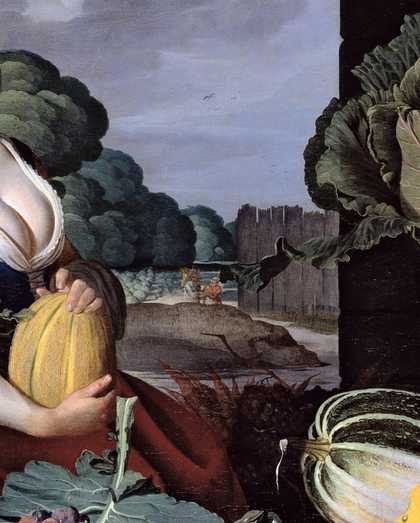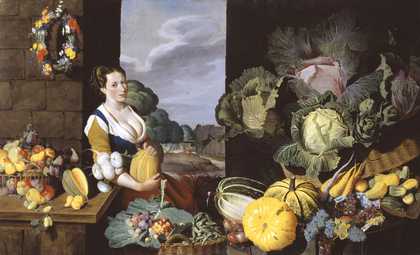
Detail of Nathaniel Bacon’s Cookmaid with Still Life of Vegetables and Fruit c.1620–5, oil paint on canvas, 151 × 247.5 cm
Photo © Tate
Good god, how do you like them cabbages? Blowsy, flowsy, bigger than your head, resplendent leaves spilling everywhere, with vulvic folds parting to reveal... even more cabbage. The paragon of peasant food, cabbage’s chemical defences against insect invasion make it stink when you cook it, causing human cabbage-eaters to fart vigorously. In Renaissance Europe, that ‘wind’ was thought to inflate the genitals – cabbage was seen as an aphrodisiac. That idea might seem absurd to modern sensibilities, but we still link cabbage and sex by saying that babies sprout in cabbage patches – a tale that was told in the cookmaid’s time.
The cookmaid sits amidst an embarrassment of titillated vegetables, with not a single puritanical kale stalk to be seen. There are hairyrooted turnips stretching towards the luscious cut melon, while a priapic purple carrot, looking wan and slightly demented, doesn’t quite manage to touch the luxuriant cabbage leaves. One of the cabbages, the forerunner of the cannibalistic plant from Little Shop of Horrors, is unfurling a leaf that resembles a shrunken hand towards the cookmaid herself, who is wanly smiling from her corner. Her only defence against incursions is a melon that’s still whole and closed – for now.
Does she invite the viewer to relish her fleshly abundance? Is she frozen with the fear of being consumed? You can only slice a melon so many times before you toss the rind away. And yet those cabbages are so florid, so voluptuous, so lush. Who could resist them?

Sir Nathaniel Bacon
Cookmaid with Still Life of Vegetables and Fruit (c.1620–5)
Tate
Cookmaid with Still Life of Vegetables and Fruit was purchased with assistance from the Art Fund in 1995 and is on display at Tate Britain as part of Walk Through British Art.
Meg Muckenhoupt is a writer on ecology, travel, history and food who lives in Lexington, MA. She is the author of Cabbage: A Global History, published by Reaktion Books.
